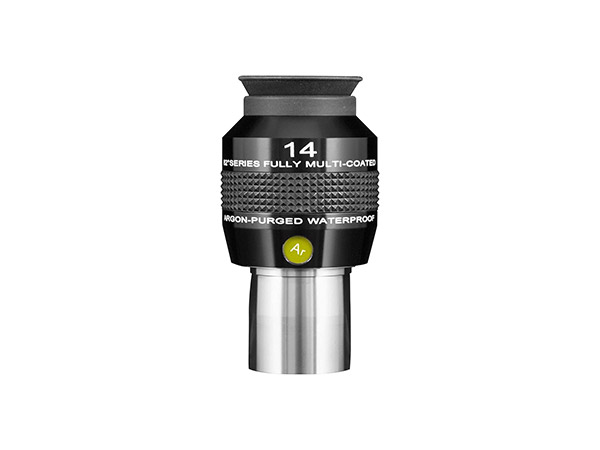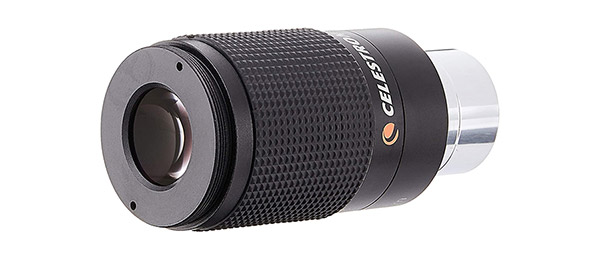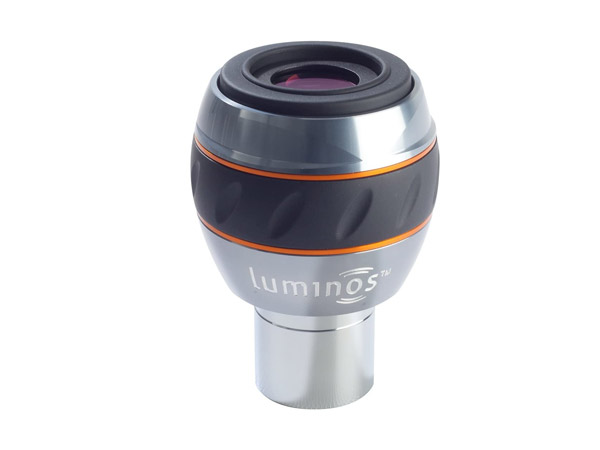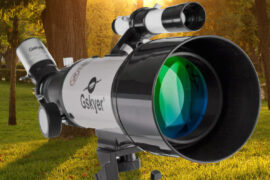So, you just got a brand new 8, 10, or 12-inch Dobsonian and you are amazed at all the power it has for such an affordable price.
But then you realize it comes with just a couple of standard 10mm and 25mm eyepieces.
Surely there are better eyepieces out there that are worthy of yielding much better views right?
Well, you’ve come to the right place.
I’ve tested dozens of combinations on different instruments to figure out which are the best eyepieces for Dobsonian telescopes. This article will guide you through the selection process. You will learn what specifications, brands, and designs you should be looking for, as well as which ones give you the best value for your money.
If you want to skip all that, click the button below to go straight to the picks.
About Dobsonian telescopes
Dobsonians are a great choice for amateur astronomy because of their versatility. They are generally on the larger side when it comes to their aperture. This means they are good for pretty much every type of target, from closer ones like the Moon and Mars to deep space objects with low brightness.
Another advantage of Dobsonians is they have an excellent size-to-price ratio. They are the most accessible type of telescope for large apertures. This is the reason why they are also known as “light buckets” because they are able to capture large amounts of light. The design of the mount is very “point-and-shoot”, making them also easy to use as they don’t have a steep learning curve.
On the other hand, the trade-off of Dobsonians is in maintenance and portability. Because of the open design, reflecting telescopes catch more dust than other types of telescopes so be ready to spend some time cleaning yours. They also need to be collimated every few months to align the mirrors.
How to pick an eyepiece for a Dobsonian
Bundled eyepieces
The first thing that you are going to want to do when choosing eyepieces for a Dobsonian is to assess the quality of your current collection.
Most telescopes these days come with two eyepieces included. Generally a 10mm and a 25mm or a 20mm.
This is a good start as it allows you to test the telescope with high and low magnification. But if you really want to get the most out of the power and versatility that a Dobsonian offers, it is not enough.
Some manufacturers cut costs by bundling low-quality eyepieces with their telescopes. This means that you are not getting the best view possible and you might be losing on sharpness, contrast, and color. To figure out the quality of your eyepieces first you need to know what type of design it has. Usually, these will be either Kellner or Plossl. You can find out which ones your telescope has on the manufacturer’s site.
Plossl eyepieces are high-quality and they use a 3-element design with good light transmission. This is the minimum quality that I’d recommend to get good images out of a Dobsonian.
Kellners on the other hand only have 2 elements and they are a very basic type of eyepiece. They are fine for many things and you can use them and get decent views, but upgrading them is generally an easy way to improve your images.
Upgrading your eyepiece collection
Building an eyepiece collection – unless you have an unlimited budget – is about versatility.
Buying expensive eyepieces that are excellent but only for specific use cases is no good. Instead, you want to cover as many magnification ranges and use cases as possible with the least amount of accessories.
Getting high-quality eyepieces is important, and I know it is the point of the article, but if you don’t have one yet, you should definitely consider a Barlow lens as one of the first key pieces of your collection. It automatically doubles the amount of magnification options you have available and maintains higher eye relief (the distance between your eye and the eyepiece) which is going to be important for comfort if you want to use high magnification EPs.
Here’s an article on the pros and cons of using Barlows vs single eyepieces to build a collection if you want more information.
Another option to consider if you are getting started and you aren’t ready to spend a lot on multiple items is a zoom eyepiece. These are EPs that have a dial that can “zoom” in and out to increase or decrease the focal length, effectively giving you 10 or 15 different sizes on a single product. The trade-off is that just by design they don’t have as good optic quality as high-end eyepieces. But if you are getting started you might not even be able to tell the difference and they are great to experiment with. This article compares the benefits of zoom and fixed eyepieces.
How expensive should your eyepieces be?
I’m taking a guess here. But the reason why you purchased a Dobsonian or you are planning to get one is because you get a lot of power and a lot of value for the money.
The eyepieces should follow this same approach.
It makes no sense to pair a Dobsonian with a premium Televue eyepiece that costs as much as the telescope. Instead, we have selected the items on this list to focus on their value ratio.
Best eyepieces for dobsonian telescopes
Best pick – Explore Scientific 82° series eyepiece

Ultra-wide field of view with amazing light transmission. A great fit for eye comfort on long stargazing sessions. Worth every penny.
Wide field of view eyepieces and Dobsonians go great together. They complement each other very well because of two reasons.
First, with all the magnification power they have, images can get extremely bright which can be uncomfortable during long viewing sessions. Having a wide field of view allows your eyes to have dark space around the object where they can rest.
Since dobs are also great for reaching dimmer deep space objects like star clusters, nebulae, and galaxies that can take up a lot of space, the wide FoV allows you to see them completely in a single view instead of having the telescope around.
This ultra-wide series by Explore Scientific has an 82° field of view. It is one of the best on the market and even though it is on the expensive side, it offers great value when compared to other similar eyepieces.
You can feel the quality of this eyepiece as soon as you pick it up. It is much heavier and bigger than your standard eyepiece, and that’s because it has a total of 7 elements (mirrors) internally. For comparison, your standard Plossl eyepiece has 3 elements.
The Explore Scientific 82° is also waterproof for easy cleaning and argon-purged which helps seal the inner elements to keep them pristine for a very long time. This is the kind of eyepiece that might outlast your telescope, making it a good long-term investment.
I am linking to the 14mm version for its versatility as it is good for all kinds of targets and it goes well with a Barlow for comfortable eye relief. But if you are looking for a high-powered EP for planetary or lunar viewing, it is also available in 6.7mm, 8.8mm, and 11mm versions.
Best value – Celestron zoom eyepiece 8mm-24mm

The fastest way to start a whole eyepiece collection with a single product. This eyepiece yields good optics at an amazing price.
It is like having 16 eyepieces in one. How much more value could you possibly want?
Zoom eyepieces are a quick -and affordable- way to add a wide array of magnification options to your arsenal when you are getting started and don’t have a big collection. Instead of switching from eyepiece to eyepiece, simply adjust the dial and the zoom eyepiece will adjust its focal length allowing you to go from high to low power fast and efficiently.
We picked the Celestron 8mm-24mm because its price is great for its quality. In fact, it’s the same eyepiece we have as our best value pick in our guide about the best zoom eyepieces. It has solid optics, good build quality, and an excellent price-to-value ratio.
While zoom eyepieces do have their limitations when it comes to optics, they make up for it by being a while box set of eyepieces on a single product. If you are a beginner and you are not ready to start spending lots of money on a whole collection, start with this.
Alternative: if you are looking for slightly better optics, and you don’t mind a higher price tag, try the Orion Lanthanum. It has the same 8mm to 24mm range but performs better.
Best for planetary viewing (high power) – Celestron X-Cel LX Series

High-quality 6-element eyepiece with a focus on high magnification observing, which is ideal to look at planets or the Moon.
Planetary and lunar viewing is the ideal use case to go test the limits of the magnification a telescope can support. Because the planets are closer than other objects, it is possible to see more details and identify some features on their surfaces and atmospheres.
To use a higher magnification on a telescope, you need an eyepiece with a lower focal length.
A narrower field of view is also optimal because it allows you to focus your eyes more on the planet you are observing instead of looking at unnecessary dark space around it (although some people actually prefer it as it feels a bit more comfortable on the eyes for long viewing sessions).
The Celestron X-Cel series is designed with these two features in mind. It has a field of view of 60° and is available in sizes of 2.3mm, 5mm, 7mm, 9mm, and 12mm. It is also available on larger options but for the use case of looking at planets and the moon, those are the ones you want to consider.
It has a 6-element design that gives them remarkable light transmission and sharpness. The lenses are high-quality and fully multi-coated so there’s no loss of brightness.
Best for deep space observing (low magnification) – Celestron Luminos

Wide eyepiece that will help you capture a large area of the sky. Unique design with a retractable eyecup and high-quality optics.
On the other end, long focal lengths (15mm+) are optimal to observe galaxies, nebulae, star clusters, and other deep space objects.
This is because the wider field of view allows you to see a larger area and these objects take up a lot of space so you don’t want to end up seeing just a piece of them at a time.
The Luminos series is an ultra-wide 82° series of eyepieces that is available on 15mm, 19mm, 23mm, and 31mm for deep space observing.
Compared to other ultra-wides, the Celestron Luminos are very affordable but offer comparable optics. If you are just starting out you won’t be able to tell the difference between this and a Televue eyepiece that costs two or three times more. They have 6 or 7 elements depending on the model.
The most unique characteristic of the Luminos series is the retractable eyecup that you can pop up or hide by twisting the barrel that makes up the body. This also makes them very comfortable to use for people that wear glasses.
The build quality and outer design are high quality and unique. Just like many of Celestron’s products, you can instantly recognize the brand by its industrial design.







